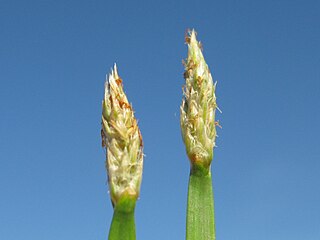
The Cyperaceae are a family of graminoid (grass-like), monocotyledonous flowering plants known as sedges. The family is large, with some 5,500 known species described in about 90 genera, the largest being the "true sedges" genus Carex with over 2,000 species.

Eleocharis is a virtually cosmopolitan genus of 250 or more species of flowering plants in the sedge family, Cyperaceae. The name is derived from the Greek words ἕλειος (heleios), meaning "marsh dweller," and χάρις (charis), meaning "grace." Members of the genus are known commonly as spikerushes or spikesedges. The genus has a geographically cosmopolitan distribution, with centers of diversity in the Amazon Rainforest and adjacent eastern slopes of the South American Andes, northern Australia, eastern North America, California, Southern Africa, and subtropical Asia. The vast majority of Eleocharis species grow in aquatic or mesic habitats from sea level to higher than 5,000 meters in elevation.
The Waipu Lagoons is a series of small coastal lagoons near the city of New Plymouth in the Taranaki Region of New Zealand. They consist of three lakelets with a combined surface area of about 2 hectares, located 0.5 kilometres (0.31 mi) from the Tasman Sea, immediately to the east of Bell Block. The lagoons plus surrounding wetlands totalling 7.9 hectares are a local purpose conservation reserve owned by the New Plymouth District Council.

Lake Barracoota is a naturally forming permanent freshwater lake located in the East Gippsland region in the Australian state of Victoria. The lake is located entirely within the Croajingolong National Park and when full, the surface area of the lake is 240 hectares.

Acacia sphacelata is a shrub of the genus Acacia and the subgenus Phyllodineae that is endemic to south western Australia.
Eleocharis acuta, commonly known as common spikerush or small spikerush, is a sedge of the family Cyperaceae that is native to Australia.
Eleocharis brassii is a sedge of the family Cyperaceae that is native to Australia.
Eleocharis caespitosissima is a sedge of the family Cyperaceae that is native to Australia.
Eleocharis jacobsiana is a sedge of the family Cyperaceae that is native to Western Australia.
Eleocharis keigheryi is a sedge of the family Cyperaceae that is native to Australia.

Eleocharis ochrostachys, commonly known as spike rush, is a sedge of the family Cyperaceae that is native to Australia and Asia.
Eleocharis pallens, commonly known as pale spikerush, is a sedge of the family Cyperaceae that is native to Australia.
Eleocharis papillosa is a sedge of the family Cyperaceae that is native to Australia.
Eleocharis philippinensis is a sedge of the family Cyperaceae that is native to Australia.
Eleocharis pusilla is a sedge of the family Cyperaceae that is native to Australia.
Eleocharis sanguinolenta is a sedge of the family Cyperaceae that is native to the Kimberley region of Western Australia.
Eleocharis spiralis is a sedge of the family Cyperaceae that is native to Australia.
Eleocharis sundaica is a sedge of the family Cyperaceae that is native to Australia.

Eleocharis plana, the flat spike-sedge, is a flat perennial sedge with creeping rhizomes, which grows up to 80 cm high in moist situations. It is widespread in inland New South Wales, and is also found in Queensland and in South Australia.
Riria Smith was a master in traditional Māori weaving from Northland in New Zealand. She was affiliated to the iwi Ngāti Kurī and the hapū Pohutiare of Te Aupōuri.






